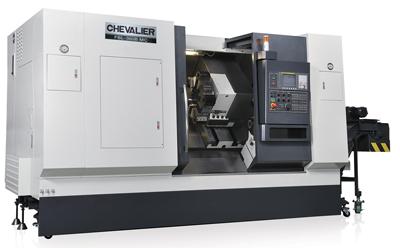
Newly designed, the FBL-360B MC from Chevalier boasts a 45-degree slant bed, rigid box ways structure and programmable tailstock. It's the best machine in the market for mixed volume, short-run or dedicated high-volume applications. The machine is engineered with ease of access and trouble-free maintenance in mind.
Here are vital specs about the FBL-360B MC:
CAPACITY: The FBL-360B MC slant bed lathe features a 15" chuck, maximum swing and maximum turning diameter of 22.4" and a maximum turning length up to 80".
STRUCTURE: The FBL-360B MC offers a flexible, accurate and efficient solution for mixed volume, short-run or dedicated high-volume applications. The ribbed Meehanite cast iron mono-block casting with high rigidity box way helps resist deflection and vibration during heavy machining. The FBL-360B MC offers a flexible, accurate and efficient solution for mixed-volume, short-run or dedicated high-volume applications, delivering fast parts machining of bars up to 4.5" in diameter at speeds up to 2,500rpm, X and Z travels of 12.6" and up to 32.2" and 708 ipm rapid traverse. The X- and Z-axes positioning accuracy is ±0.0002" while repeatability is ±0.0001".
SPINDLE: The lathe features up to 35HP (50HP optional) AC digital spindle motor with 2-speed gear box, spindle bar is 4.5" in diameter and speed up to 2,500rpm. It produces up to 1,901 ft.-lbs. torque at lower rpm and has a 5.3 spindle bore.
TURRET: The German made Sauter 12-station BMT 65 live turret offers smooth and fast indexing time, while the 15HP live motor provides large torque to satisfy most milling work.
CONTROL: FANUC 0i-TD control with 10.4" LCD color screen and conversational Manual Guide i.
ACCESSORIES: Auto tool setter system helps to reduce set-up times and keep non-machining times to a minimum. Programmable tailstock comes with automatic positioning capability, along with programmable quill that runs IN/OUT sequence.
Contact Details
Related Glossary Terms
- chuck
chuck
Workholding device that affixes to a mill, lathe or drill-press spindle. It holds a tool or workpiece by one end, allowing it to be rotated. May also be fitted to the machine table to hold a workpiece. Two or more adjustable jaws actually hold the tool or part. May be actuated manually, pneumatically, hydraulically or electrically. See collet.
- gang cutting ( milling)
gang cutting ( milling)
Machining with several cutters mounted on a single arbor, generally for simultaneous cutting.
- inches per minute ( ipm)
inches per minute ( ipm)
Value that refers to how far the workpiece or cutter advances linearly in 1 minute, defined as: ipm = ipt 5 number of effective teeth 5 rpm. Also known as the table feed or machine feed.
- lathe
lathe
Turning machine capable of sawing, milling, grinding, gear-cutting, drilling, reaming, boring, threading, facing, chamfering, grooving, knurling, spinning, parting, necking, taper-cutting, and cam- and eccentric-cutting, as well as step- and straight-turning. Comes in a variety of forms, ranging from manual to semiautomatic to fully automatic, with major types being engine lathes, turning and contouring lathes, turret lathes and numerical-control lathes. The engine lathe consists of a headstock and spindle, tailstock, bed, carriage (complete with apron) and cross slides. Features include gear- (speed) and feed-selector levers, toolpost, compound rest, lead screw and reversing lead screw, threading dial and rapid-traverse lever. Special lathe types include through-the-spindle, camshaft and crankshaft, brake drum and rotor, spinning and gun-barrel machines. Toolroom and bench lathes are used for precision work; the former for tool-and-die work and similar tasks, the latter for small workpieces (instruments, watches), normally without a power feed. Models are typically designated according to their “swing,” or the largest-diameter workpiece that can be rotated; bed length, or the distance between centers; and horsepower generated. See turning machine.
- milling
milling
Machining operation in which metal or other material is removed by applying power to a rotating cutter. In vertical milling, the cutting tool is mounted vertically on the spindle. In horizontal milling, the cutting tool is mounted horizontally, either directly on the spindle or on an arbor. Horizontal milling is further broken down into conventional milling, where the cutter rotates opposite the direction of feed, or “up” into the workpiece; and climb milling, where the cutter rotates in the direction of feed, or “down” into the workpiece. Milling operations include plane or surface milling, endmilling, facemilling, angle milling, form milling and profiling.
- rapid traverse
rapid traverse
Movement on a CNC mill or lathe that is from point to point at full speed but, usually, without linear interpolation.
- turning
turning
Workpiece is held in a chuck, mounted on a face plate or secured between centers and rotated while a cutting tool, normally a single-point tool, is fed into it along its periphery or across its end or face. Takes the form of straight turning (cutting along the periphery of the workpiece); taper turning (creating a taper); step turning (turning different-size diameters on the same work); chamfering (beveling an edge or shoulder); facing (cutting on an end); turning threads (usually external but can be internal); roughing (high-volume metal removal); and finishing (final light cuts). Performed on lathes, turning centers, chucking machines, automatic screw machines and similar machines.

